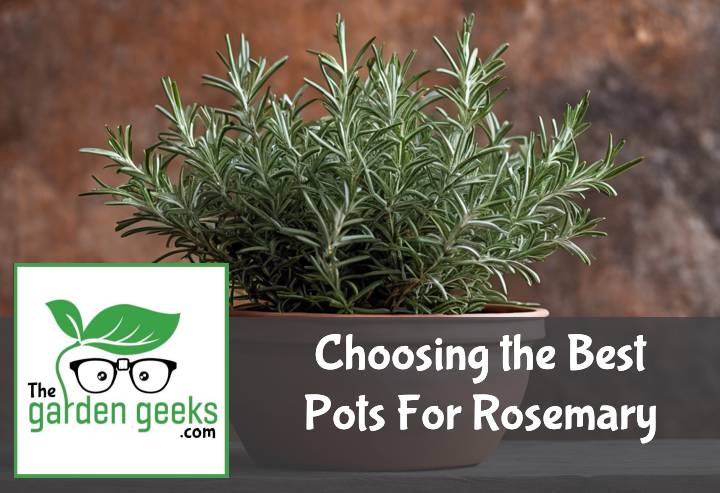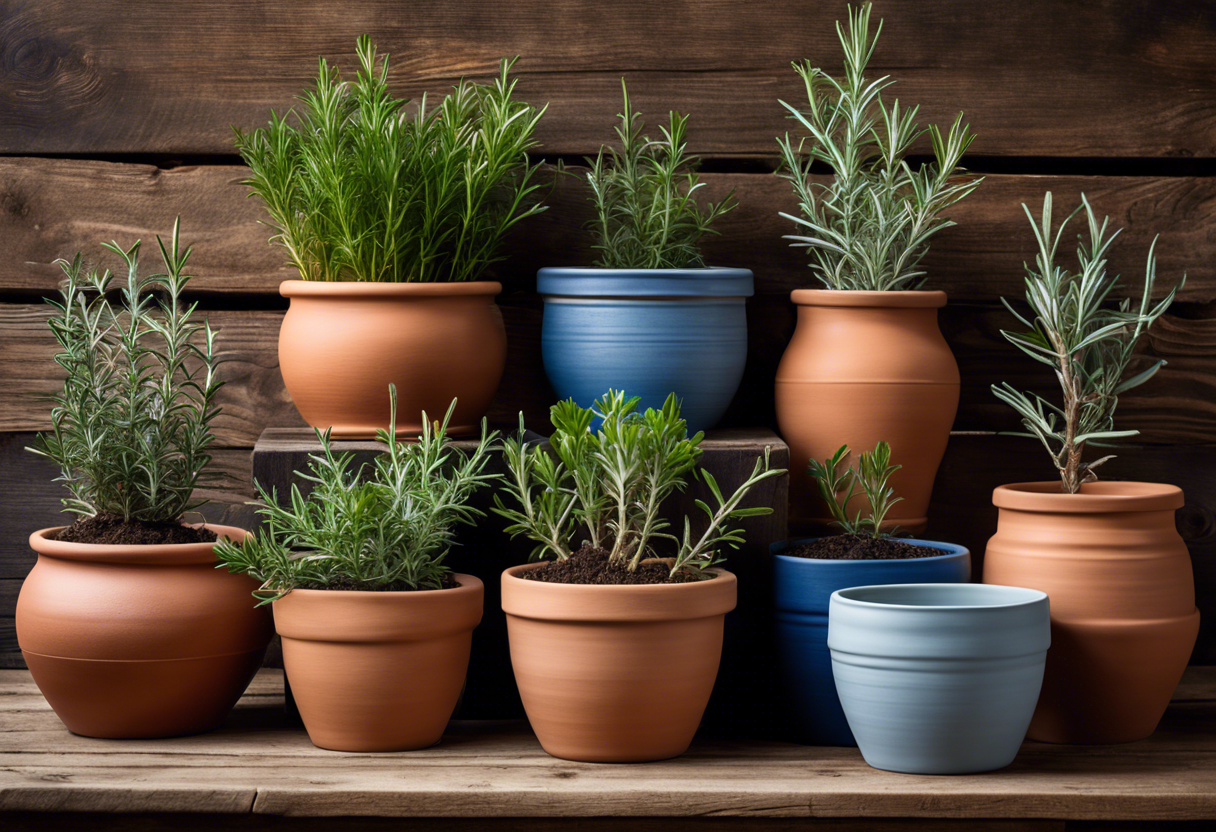Ah, rosemary! That delightful herb that adds a punch to your roast and a fragrant charm to your garden. But let’s face it, Choosing the Best Pots For Rosemary can be as tricky as trying to untangle Christmas lights after a year in the attic.
Don’t worry though, we’re here to shine a light on this conundrum. So, buckle up and get ready for an adventure in pot selection – it’s more exciting than you might think! Keep reading about Choosing the Best Pots For Rosemary (With Examples).
Key Takeaways
- Terra cotta pots are ideal for rosemary due to their porous nature, allowing the soil to dry out completely.
- Choose a pot with good drainage to prevent waterlogging and root rot.
- The size of the pot should be proportional to the size of the plant; a 12-inch pot is generally suitable.
- Examples include: “MyGift 8-inch Terracotta Planter”, “Novelty Round Moonstone Planter”, and “Classic Home and Garden Whiskey Barrel”.
Why is Choosing the Right Pot for Rosemary Important?
When it comes to rosemary plant care, one of the most crucial decisions you’ll make is choosing the best pots for rosemary. It’s not just about aesthetics, folks! The type of pot you select can significantly influence your rosemary’s growth habits and overall health.
Understanding the Growth Habits of Rosemary
Rosemary has some unique growth habits that need to be considered when picking a pot. This Mediterranean herb loves well-drained soil and plenty of sunlight. Now, if you’re thinking “I’ll just stick it in any old pot,” hold your horses!
Understanding these rosemary growth habits can help inform better pot selection. For instance, a shallow, wide pot might seem like a good idea at first glance. But remember that rosemary roots grow deep and need room to stretch out. So, a deeper pot would be more beneficial.
The Impact of Pot Selection on Rosemary’s Health and Productivity
Now let’s talk about how pot selection impacts our green friend’s health and productivity. A poorly chosen pot can lead to waterlogged roots or insufficient space for growth – both big no-nos in the world of rosemary care.
On the flip side, choosing pots for rosemary that provide adequate drainage and enough room for root expansion can lead to healthier, more productive plants. So next time you’re at the garden store, remember – picking the right pot isn’t just about what looks pretty on your patio!
What Factors to Consider When Choosing the Best Pots For Rosemary?
When it comes to rosemary pot selection, there’s more than meets the eye. You can’t just grab any old container and expect your rosemary to thrive.
Material of the Pot
The material of your pot plays a big role in your rosemary’s health. Clay pots for rosemary, for instance, are breathable and great for moisture control. But they can be heavy and prone to cracking in cold weather.
On the other hand, plastic pots for rosemary are lightweight and less fragile. But they may not provide as much breathability, which could lead to overwatering issues.
Size and Depth of the Pot
Size matters when it comes to rosemary pot size. A small pot might cramp your plant’s style (and roots), while a large one could lead to waterlogging.
Depth is equally important. Deep pots for rosemary allow roots plenty of room to grow, promoting healthier plants overall. So, when you’re deciding between small pots vs large pots for rosemary, consider both width and depth!
Drainage Capabilities
Last but certainly not least, let’s talk about drainage. Good drainage is key to preventing root rot and keeping your rosemary happy.
Some pots have better drainage in rosemary pots than others. For example, clay or terracotta pots tend to offer excellent drainage because they’re porous.
So remember folks, when it comes down to it, the best draining pots for rosemary are those that balance moisture control with breathability!
How Does Each Type of Pot Material Affect Rosemary Growth?
When choosing the best pots for rosemary, it’s crucial to consider how different pot materials can impact your plant’s health and growth. Let’s dive into the nitty-gritty of each material, shall we?
Terracotta Pots
Ah, terracotta pots! They’re a classic choice for rosemary plant care due to their breathability. These pots allow excess water to evaporate, preventing root rot and promoting healthy growth.
But wait, there’s more! Terracotta also excels at temperature regulation. It keeps the soil cool even on hot summer days, making it perfect for heat-sensitive rosemary.
However, they do have their downsides. Terracotta is porous and can dry out quickly. So if you’re a forgetful waterer (no judgment here), you might want to think twice!
Plastic Pots
Next up are plastic pots. Lightweight and durable, these bad boys are easy to move around – great news if you love redecorating or live in an apartment with limited space.
They also offer excellent insulation properties which help maintain stable soil temperatures. This makes them a solid choice when choosing the best pots for rosemary.
On the flip side though, plastic isn’t breathable like terracotta. So be careful not to overwater your rosemary or it could end up swimming instead of growing!
Ceramic Pots
Ceramic pots? More like chic-ramic pots! These heavy-duty containers add a touch of elegance to your indoor or outdoor garden while providing excellent heat retention for your rosemary plants.
But remember folks, with great aesthetics comes great weight (literally). Ceramic pots can be quite heavy so make sure you’re ready for some lifting!
Also worth noting: they don’t dry out as quickly as terracotta but faster than plastic. So keep an eye on your watering schedule.
Metal Pots
Last but not least, let’s talk about metal pots. These durable containers are all about that heat conduction life. They warm up quickly, which can be a plus or a minus depending on your local climate.
But beware! Metal pots can get super hot in the sun and may scorch your rosemary’s roots. So if you live somewhere with blazing summers, it might be best to stick to other materials.
And there you have it! The lowdown on how different pot materials affect rosemary growth. Remember folks, pot material effects are just as important as the care you provide!
When it comes to choosing the best pots for rosemary, there are a few options that stand out. Each has its own unique benefits and potential drawbacks, depending on your specific needs and circumstances.
Example 1: Terracotta Pot for Rosemary
Terracotta pots are a classic choice for many gardeners. They’re praised for their ability to breathe, allowing air and water to pass through their walls. This helps prevent overwatering, a common issue when growing rosemary. However, they can also dry out quickly in hot weather or if not watered regularly. So, if you’re someone who tends to forget about watering your plants, terracotta might not be the best option for you.
Example 2: Plastic Pot for Rosemary
Plastic pots offer a lightweight and often cheaper alternative to other types of pots. They retain moisture well which can be beneficial in hotter climates or during summer months. However, this can also lead to waterlogging if you’re not careful with your watering schedule. Plus, they don’t breathe like terracotta does, so they may not provide the best environment for rosemary’s roots.
Example 3: Ceramic Pot for Rosemary
Ceramic pots are another excellent choice when growing rosemary. Like terracotta, they allow air and water movement through their walls which helps keep the roots healthy. They’re also typically heavier than plastic or metal pots which can provide stability in windy conditions. On the downside though, ceramic pots can be quite heavy and more fragile than other options.
Example 4: Metal Pot for Rosemary
Finally, we have metal pots. These are durable and long-lasting options that can add a sleek look to your garden or home decor. They’re great at retaining heat which can help keep your rosemary warm during colder months. However, this could also cause the soil to heat up too much during hot weather, potentially damaging the roots. So, if you live in a particularly hot climate, you might want to think twice about using a metal pot for your rosemary.
Common Mistakes to Avoid When Choosing the Best Pots For Rosemary
When it comes to rosemary pot mistakes, there are a few common ones that can really throw a wrench in your green thumb ambitions. Let’s dive into some of these pitfalls.
Overly Large or Small Pots
First up, we have the classic error of choosing the wrong pot size for rosemary. You might think bigger is better, but not so fast! An overly large pot can lead to waterlogging and root rot because the soil stays wet for too long.
On the flip side, small pots and rosemary don’t mix well either. A tiny pot restricts root growth, which can stunt your plant’s development and make it more susceptible to disease. So remember, size does matter when it comes to pots!
Inadequate Drainage Holes
Another common mistake is overlooking the importance of drainage. If your pot doesn’t have enough holes, you’re setting yourself up for trouble.
Inadequate drainage leads to waterlogged soil, which is a one-way ticket to root rot city for your rosemary plant. So always check those drainage holes before you buy!
Wrong Material Choice
Lastly, let’s talk about material choice. Some folks don’t realize that certain materials just aren’t cut out for growing rosemary.
For instance, plastic pots might seem like a good idea because they’re lightweight and cheap. But they’re not great at moisture control or heat retention – two things rosemary plants need to thrive.
So when choosing the best pots for rosemary, steer clear of unsuitable materials that could hinder your plant’s growth.
To Wrap Up
In the grand game of botanical bingo, Choosing the Best Pots For Rosemary is like finding the perfect pair of jeans – it has to fit just right. We’ve dished out the dirt on drainage, material choices and size considerations.
So now it’s your turn! Get out there, find that pot that’s ‘just right’ for your rosemary and watch it flourish. Remember, happy pots make for happy plants!





